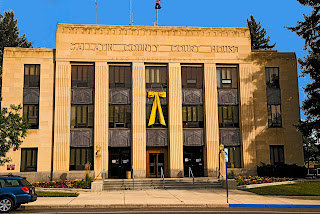6
 Albert Gallatin was Thomas Jefferson's Secretary of the Treasury, which meant, in effect, that he paid the bills for the Corps of Discovery--the Lewis and Clark Expedition. When the famed explorers reached the point where three rivers come together to form the Missouri River, they named the three for the President, the Secretary of State (James Madison), and the Secretary of the Treasury. The Gallatin River flows north out of Yellowstone National Park and traverses the long and narrow Gallatin County, till it merges with the Madison and Jefferson Rivers to form the Missouri.
Albert Gallatin was Thomas Jefferson's Secretary of the Treasury, which meant, in effect, that he paid the bills for the Corps of Discovery--the Lewis and Clark Expedition. When the famed explorers reached the point where three rivers come together to form the Missouri River, they named the three for the President, the Secretary of State (James Madison), and the Secretary of the Treasury. The Gallatin River flows north out of Yellowstone National Park and traverses the long and narrow Gallatin County, till it merges with the Madison and Jefferson Rivers to form the Missouri.The eastern most of the "settled" counties when Montana territory was created, Gallatin County was given the the administration of Big Horn County as well. Big Horn County (later renamed Custer County after the Battle of the Little Big Horn, or Custer's Last Stand), covered all of what is now eastern Montana, but had so few people living within its boundaries, that there weren't enough people to actually represent the county.
Today, Gallatin County is the third most populous in Montana, and has been the fastest growing county for several years now. The outlying communities of Belgrade and Manhattan seem to have new housing developments springing up every time I pass by them on Interstate-90.
Bozeman and Gallatin County are home to the largest number of IT services in the state. They are also home to Montana State University and The Museum of the Rockies. The latter, while nominally a part of the University, is best known for being the child of paleontologist Jack Horner, himself known for his work with T. Rex skeletons found in Montana and for lending (or probably selling) his expertise to the Jurassic Park films.
On a literary front, Bozeman was home to Robert Pirsig when he wrote his Inquiry into Values, Zen and the Art of Motorcycle Maintenance. Bozeman is also, therefore, the starting point for the cross-country motorcycle trip that forms the framework of that book. On a personal note, I included Pirsig in my dissertation's bibliography, and if you have read the book and wonder what a cross-country motorcycle ride has to do with a fascist French novelist, then I beg you to go back and reread the book. It is one of the clearest explanations of the difference between the classical and the romantic mindset I've ever come across. Of course, you might not be interested in that particular difference. The book is still a great read about a trip by motorcycle. (But it's so much more, the little voice in the back of my aborted literature professor's head screams.)
 The Bridger Mountains, as seen through the windows of the Montana Ale Works
The Bridger Mountains, as seen through the windows of the Montana Ale WorksThe city of Bozeman sits in a dramatic setting at the foot of the Bridger Mountains. As you drive east across the city on Interstate 90, almost immediately after the last Bozeman exit, you start climbing toward Bozeman Pass and the county line with Park County (Number 49). I have long felt this stretch of I-90 is one of the most scenic drives in the state, but be prepared. I've been caught in blizzards on Bozeman Pass in June. The Bridger Mountains are also home to Bridger Bowl, one of Montana's premier ski resorts.
South of Bozeman, along the highway to the western entrance to Yellowstone National Park, sits Big Sky, a year-round resort originally begun by national newscaster Chet Huntley, a Montana native and MSU alumnus who returned to Montana after retiring from NBC news.
Even further south, in the southern-most point of Montana, sits the town of West Yellowstone, one of the five entrances to Yellowstone National Park. While most of the land area for the park is in the state of Wyoming, three of the park's five entrances are in Montana.
South of Bozeman, along the highway to the western entrance to Yellowstone National Park, sits Big Sky, a year-round resort originally begun by national newscaster Chet Huntley, a Montana native and MSU alumnus who returned to Montana after retiring from NBC news.
Even further south, in the southern-most point of Montana, sits the town of West Yellowstone, one of the five entrances to Yellowstone National Park. While most of the land area for the park is in the state of Wyoming, three of the park's five entrances are in Montana.
 Grain Elevator in downtown Bozeman, Montana
Grain Elevator in downtown Bozeman, MontanaDespite the Hi-Tech, Education and other businesses in Bozeman and Gallatin County, it is still a largely agricultural place. Population growth in Gallatin County, indeed across Montana, has led to disputes as the new-comers have both an idealized view of country living and often times big-city expectations. The Gallatin County Commissioners, taking their lead from western novelist Zane Grey, have put together a Code of the New West to help people adapt. It's a good read, and I recommend that anyone thinking of leaving the city for the country, whether in Montana or elsewhere, give it a read.
The U.S. Census counts and estimates show the rapid rate of growth here. The 1950 count indicated that there were 21,902 county residents. That grew 18.9% during the 50s to 26,045 in the 1960 count. The 1960s showed a growth rate of 24.8% with a 1970 count of 34,505. That number more than doubled by the 2000 census which showed 67,831 county residents, or 26 people per square mile in this 2,606 square mile county. While the 2010 numbers are not yet available, the increase shown in the 2008 census estimates indicate that the growth just continues, with a 32.4% increase from 2000 to 2008 and an estimated population of 89,824 in 2008, or a population that has more than tripled in the last sixty years.
The U.S. Census counts and estimates show the rapid rate of growth here. The 1950 count indicated that there were 21,902 county residents. That grew 18.9% during the 50s to 26,045 in the 1960 count. The 1960s showed a growth rate of 24.8% with a 1970 count of 34,505. That number more than doubled by the 2000 census which showed 67,831 county residents, or 26 people per square mile in this 2,606 square mile county. While the 2010 numbers are not yet available, the increase shown in the 2008 census estimates indicate that the growth just continues, with a 32.4% increase from 2000 to 2008 and an estimated population of 89,824 in 2008, or a population that has more than tripled in the last sixty years.






1 comment:
good..../
cure of black magic
http://blackmagicremoveswithquran.blogspot.com/
Post a Comment